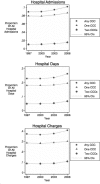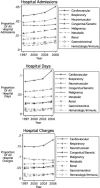Children with complex chronic conditions in inpatient hospital settings in the United States
- PMID: 20855394
- PMCID: PMC2962571
- DOI: 10.1542/peds.2009-3266
Children with complex chronic conditions in inpatient hospital settings in the United States
Abstract
Objectives: Hospitalized children are perceived to be increasingly medically complex, but no such trend has been documented. The objective of this study was to determine whether the proportion of pediatric inpatient use that is attributable to patients with a diagnosis of one or more complex chronic condition (CCC) has increased over time and to assess the degree to which CCC hospitalizations are associated with attributes that are consistent with heightened medical complexity.
Methods: A retrospective observational study that used the 1997, 2000, 2003, and 2006 Kids Inpatient Databases examined US hospitalizations for children. Attributes of medical complexity included hospital admissions, length of stay, total charges, technology-assistance procedures, and mortality risk.
Results: The proportion of inpatient pediatric admissions, days, and charges increased from 1997 to 2006 for any CCC and for every CCC group except hematology. CCCs accounted for 8.9% of US pediatric admissions in 1997 and 10.1% of admissions in 2006. These admissions used 22.7% to 26.1% of pediatric hospital days, used 37.1% to 40.6% of pediatric hospital charges, accounted for 41.9% to 43.2% of deaths, and (for 2006) used 73% to 92% of different forms of technology-assistance procedures. As the number of CCCs for a given admission increased, all markers of use increased.
Conclusions: CCC-associated hospitalizations compose an increasing proportion of inpatient care and resource use. Future research should seek to improve methods to identify the population of medically complex children, monitor their increasing inpatient use, and assess whether current systems of care are meeting their needs.
Figures


Comment in
-
Impact of children with medically complex conditions.Pediatrics. 2010 Oct;126(4):789-90. doi: 10.1542/peds.2010-1885. Epub 2010 Sep 20. Pediatrics. 2010. PMID: 20855381 No abstract available.
References
-
- Newacheck PW, Strickland B, Shonkoff JP, et al. An epidemiologic profile of children with special health care needs. Pediatrics. 1998;102(1 pt 1):117–123. - PubMed
-
- Elixhauser A, Machlin SR, Zodet MW, et al. Health care for children and youth in the United States: 2001 annual report on access, utilization, quality, and expenditures. Ambul Pediatr. 2002;2(6):419–437. - PubMed
-
- Wise PH. The transformation of child health in the United States. Health Aff (Millwood) 2004;23(5):9–25. - PubMed
-
- Srivastava R, Stone BL, Murphy NA. Hospitalist care of the medically complex child. Pediatr Clin North Am. 2005;52(4):1165–1187. x. - PubMed
Publication types
MeSH terms
Grants and funding
LinkOut - more resources
Full Text Sources
Medical
Research Materials

